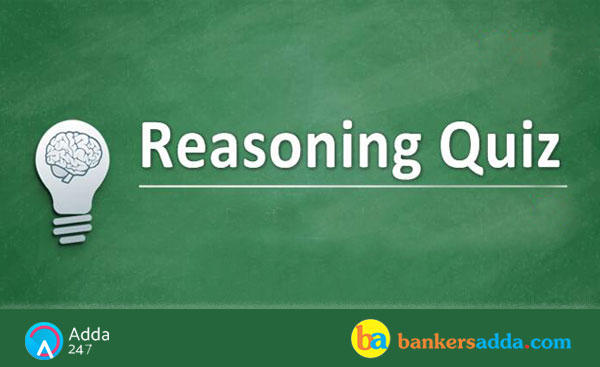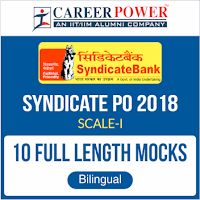Dear Aspirants,
Reasoning Ability is an onerous section. With the increasing complexity of questions, it becomes hard for one to give it the cold shoulder. The only way to make the grade in this particular section in the forthcoming banking exams is to practice continuously with all your heart and soul. And, to let you practice with the best of the latest pattern questions, here is the Adda247 Night Reasoning Quiz based on the exact same pattern of questions that are being asked in the exams.
Directions (1-5): Read the following information carefully and answer the questions that follow.
Twelve workers are sitting in two parallel rows containing six workers in each row. In row 1, P, Q R, S, T and U are sitting and all of them are facing towards north direction. In row 2, A, B, C, D, E and F are sitting and all of them are facing towards south direction. In the given seating arrangement, each member seated in a row faces another member of the other row but not necessarily in the same order. Each of them earns different wages on daily basis viz. $21, $35, $49, $51, $53, $70, $75, $79, $81, $83, $85 and $89 but not necessarily in the same order.
No two successive workers are sitting together according to alphabetical order. For Example: A does not sit with B; similarly, B does not sit with C and so on.
A sit third to left of E and none of them sits on the extreme ends of the line. Immediate neighbor of A faces the person who earns $89. There is one person sits between the one who earns $89 and U. Immediate neighbor of E faces T. Immediate neighbor of B faces S. Immediate neighbor of R faces the one who earns $51. There are two persons sit between the one who earn $51 and the one who earns $81. D does not sit adjacent to B. One of the immediate neighbor of A earns $85. There are two persons sit between the one who earns $85 and the one who earns $79. The immediate neighbor of one who earns $79 faces the one who earns $83. The one who earns $75 sits third to right of one who earns $70. A does not earn $75. The one who earns $53 sits on the immediate right of one who earns $79. The immediate neighbor of one who earns $53 does not earn $49. A does not earn $49. The one who earns $49 faces the one who earns $35.
Q1. What is the daily wages of Q?
(a) $70
(b) $89
(c) $49
(d) $75
(e)$85
Q2. Who among following earns $21?
(a) P
(b) Q
(c) R
(d) S
(e) T
Q3. Who among following sits second to the right of D?
(a) A
(b) E
(c) C
(d) B
(e) F
Q4. Four of the following five are alike in a certain way and hence they form a group. Which one of the following does not belong to that group?
(a) F
(b) U
(c) D
(d) T
(e) C
Q5. Who among following faces F?
(a) T
(b) R
(c) S
(d) Q
(e) P
Directions (6-10): In each of these questions the symbols @, #, $, % and * are used with different meanings as follows.
I. ‘P @ Q’ means ‘P is not smaller than Q’.
II. ‘P # Q’ means ‘P is not greater than Q’.
III. ‘P $ Q’ means ‘P is neither smaller than nor greater than Q’.
IV. ‘P % Q’ means ‘P is neither smaller than nor equal to Q’.
V. ‘P * Q’ means ‘P is neither greater than nor equal to Q’.
In each question, four statements showing relationships have been given, which are followed by four conclusions I, II, III and IV. Assuming that the given statements are true, find out which conclusion(s) is/are definitely true.
Q6. Statements: M # N, N * O, O @ P, P $ Q
Conclusions:
I. Q * O
II. Q # O
III. M * O
IV. Q $ M
(a) I and III are true
(b) II and III are true
(c) III and IV are true
(d) I and II are true
(e) None of the above
Q7. Statements: A $ B, B @ C, C % D, E * D
Conclusions:
I. A @ C
II. E * B
III. B % D
IV. A % D
(a) None is true
(b) I and II are true
(c) II and III are true
(d) I, II and III are true
(e) All are true
Q8. Statements: A @ B, B * C, C # D, D % E
Conclusions:
I. B % E
II. A @ D
III. B # E
IV. A * D
(a) Either I or III is true
(b) Either II or IV is true
(c) II and III are true
(d) Either I or III and either II or IV are true
(e) None is true
Q9. Statements: A % B, B # C, C @ D, D $ E
Conclusions:
I. C % E
II. A @ C
III. A * C
IV. B $ D
(a) Either II or III is true
(b) Only I is true
(c) Only IV is true
(d) I and II are true
(e) None of the above
Q10. Statements: T % U, U @ V, V * Z, Z # X
Conclusions:
I. T @ V
II. T % V
III. X @ V
IV. X % V
(a) I and III are true
(b) II and III are true
(c) II and IV are true
(d) All are true
(e) None of these
Directions (11-15): Read each statement carefully and answer the following questions:
Q11.Which of the following expressions will be true if the expression Z> O = Y> S
(a) O >C
(b) Z>S
(c) C>Y
(d) S = O
(e)C
Q12.Which of the following symbols should replace the question mark (?) in the given expression in order to make the expressions B>A as well as U≤V definitely true?
B>V? A ≥ N = U
(a) ≤
(b) >
(c) <
(d)≥
(e)Either ≤ or <
Q13.Which of the following symbols should be placed in the blank spaces respectively (in the same order from left to right) in order to complete the given expression in such a manner that makes the expression Y>Z as well as X≤W definitely true?
Y _ W _ O _ Z _ X
(a) =, =, ≥, ≥
(b) >, ≥, =, >
(c) >, <, =, ≤
(d)>, =, =, ≥
(e)>, =, ≥, >
Q14.Which of the following should be placed in the blank spaces respectively (in the same order from left to right) in order to complete the given expression in such a manner that makes the expression Z
_ ≤ _ < _ > _
(a) L, N, X, Z
(b) L, Z, X, N
(c) Z, L, X, N
(d) N, Z, X, L
(e)X, N, Z, L
Q15.Which of the following symbols should be placed in the blank spaces respectively (in the same order from left to right) in order to complete the given expression in such a manner that makes the expression A>B and C>E definitely false?
A _ O _ C _ B _ E
(a) <, <, >, =
(b) <, =, =, >
(c) <, =, =, <
(d) ≥, =, =, ≥
(e)>, >, =, <




 Reasoning Quiz For Bank Foundation 2024 ...
Reasoning Quiz For Bank Foundation 2024 ...
 Reasoning Quiz For Bank Foundation 2024 ...
Reasoning Quiz For Bank Foundation 2024 ...



